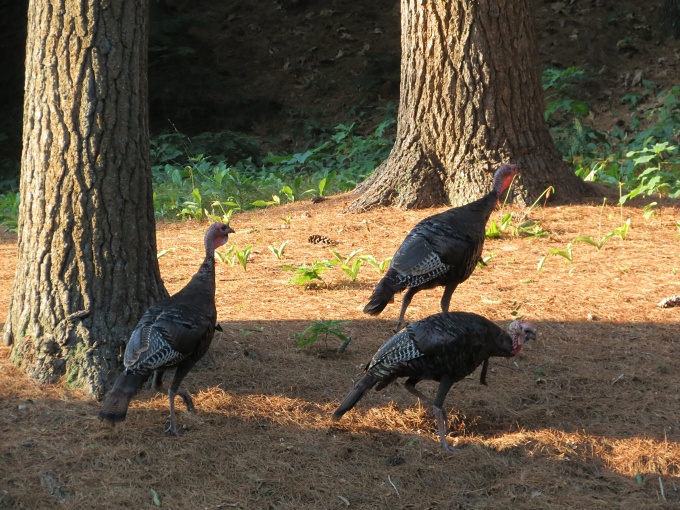Wild Turkey - the non-alcoholic kind
/I love waking in the morning to the sound of birds. Cheeps, chirps, twitters, tweets and trills ... high pitch, low pitch ...single-notes and complicated riffs. It's lovely. The once blissful sound of little songbirds has been replaced by big guy gobbles now and, frankly, it's not quite as pleasant.
The turkey alarm must go off just before first light because the total quiet suddenly erupts into a cacophony of sound, every turkey for himself and the day has begun. These wild turkeys are on the prowl early in the day. The neighborhood flock evidently roosts nearby and for some mysterious reason, their turkey path takes them just outside of our window and man, are they ever noisy. Each morning … way too early for civilized, urban turkeys to be out and about … a gang of vociferous birds troops past, gobbling and gossiping, probably about some turkeys from another neighborhood who hog all the good food. They take the same track past the window to their nighttime roosts and we can always hear them discussing their day's activities.
We saw our first wild turkeys when we lived in Wisconsin and were mightily impressed by their size. These are big, honkin' birds and they don't look like Butterballs at all. They're weird looking with all those dark feathers and that fleshy red thing that hangs over the male's beak ... better known as a snood and very sexy to the girl turkeys, I'm told. Then there's the wattle, another red, fleshy bit that hangs under their chins. I'm sure they're handsome to each other, but honestly, I just can't see it. I do, however, appreciate the fact that they're wild and free. I don't appreciate their racket so early in the morning.
Turkeys are native to North America and their numbers dwindled drastically in the 1930's until they became nearly extinct. Due to conservation efforts, the five species in North America now number in the millions and they're prime hunting game around this time of year.
In our neighborhood, they're pretty safe though … no discharging of firearms within city limits. Smart turkeys!
North American turkeys are primarily brown. The males have iridescent colored feathers of red, green, bronze and copper, but like most bird species, the females are drab. We saw wild turkeys quite frequently in Australia including domesticated, pure white ones. People don't eat turkey so much in Australia and as such, it requires a small mortgage to purchase one for the holidays. We always do, but it's painful. Compare the $75 we paid for a 10 lb (4.5kg) in Oz to the “free with purchase” or 19 cents/lb deals in the US around the holidays.
Believe it or not, there's a National Wild Turkey Federation that provides information on important topics like successful turkey hunts, turkey dogging and mouth calls simplified. They have their own magazine, Turkey Country. You can take a turkey quiz and test your knowledge of wild turkeys. You can even listen to wild turkey sounds if you want and make them a ring tone on your cell phone… or you can come over and sit by our window at 0600.







